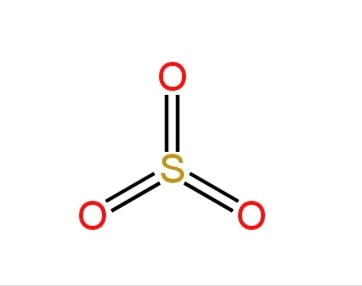
The geometry of the sulfur trioxide molecule is
A. Tetrahedral
B. Trigonal planar
C. Pyramidal
D. Square planar
Answer
224.7k+ views
Hint:Sulfur trioxide is a chemical compound having the formula SO₃.
It is a combination of one sulfur atom and three oxygen atoms.
Each oxygen atom is doubly bonded to the sulfur atom.
Complete step by step solution:Here in this question, we have to find out the geometry or structure of sulfur trioxide.
We know that the structure of a molecule is predicted by VSEPR theory.
Let us know about it.
VSEPR or valence shell electron pair repulsion theory has some postulates. These can be explained briefly as follows: -
The shape of the molecule relies on the no. of valence shell electron pairs around the main atom even if they are not bonded.
Pairs of electrons in the valence shell all are negatively charged and accordingly, repulsed by one another.
These pairs of electrons try to lessen the repulsion and therefore stay distant and separated from each other.
Lone pair-lone pair repulse each other intensely. Then comes lone pair-bond pair repulsion and bond pair-bond pair repulsion.
The sulfur trioxide molecule has each oxygen doubly bonded to the sulfur atom.
There are six bond pairs of electrons and no lone pairs.
There are three sigma bonds and three pi-bonds.
Thus, there is \[s{p^2}\] hybridization.
The valency of sulfur is fully satisfied.
But while predicting the geometry we can assume that there are 3 bond pairs as multiple bonds are taken as only one electron group.
Using VSEPR theory, we can say that the geometry is a trigonal planar.
The structure is as follows:-

Image: Sulfur trioxide
So, option B is correct.
Note: A molecule whose central atom has only two electron groups is organized so that two groups are as far away from each other. So, these two electron groups are \[180^\circ\] apart. Therefore, the general molecular shape is linear. For example,\[BeC{l_2},C{O_2}\].
It is a combination of one sulfur atom and three oxygen atoms.
Each oxygen atom is doubly bonded to the sulfur atom.
Complete step by step solution:Here in this question, we have to find out the geometry or structure of sulfur trioxide.
We know that the structure of a molecule is predicted by VSEPR theory.
Let us know about it.
VSEPR or valence shell electron pair repulsion theory has some postulates. These can be explained briefly as follows: -
The shape of the molecule relies on the no. of valence shell electron pairs around the main atom even if they are not bonded.
Pairs of electrons in the valence shell all are negatively charged and accordingly, repulsed by one another.
These pairs of electrons try to lessen the repulsion and therefore stay distant and separated from each other.
Lone pair-lone pair repulse each other intensely. Then comes lone pair-bond pair repulsion and bond pair-bond pair repulsion.
The sulfur trioxide molecule has each oxygen doubly bonded to the sulfur atom.
There are six bond pairs of electrons and no lone pairs.
There are three sigma bonds and three pi-bonds.
Thus, there is \[s{p^2}\] hybridization.
The valency of sulfur is fully satisfied.
But while predicting the geometry we can assume that there are 3 bond pairs as multiple bonds are taken as only one electron group.
Using VSEPR theory, we can say that the geometry is a trigonal planar.
The structure is as follows:-

Image: Sulfur trioxide
So, option B is correct.
Note: A molecule whose central atom has only two electron groups is organized so that two groups are as far away from each other. So, these two electron groups are \[180^\circ\] apart. Therefore, the general molecular shape is linear. For example,\[BeC{l_2},C{O_2}\].
Recently Updated Pages
JEE Main 2026 Session 1 Correction Window Started: Check Dates, Edit Link & Fees

JEE Isolation, Preparation and Properties of Non-metals Important Concepts and Tips for Exam Preparation

Isoelectronic Definition in Chemistry: Meaning, Examples & Trends

Ionisation Energy and Ionisation Potential Explained

Iodoform Reactions - Important Concepts and Tips for JEE

Introduction to Dimensions: Understanding the Basics

Trending doubts
JEE Main 2026: City Intimation Slip and Exam Dates Released, Application Form Closed, Syllabus & Eligibility

JEE Main 2026 Application Login: Direct Link, Registration, Form Fill, and Steps

Understanding the Angle of Deviation in a Prism

How to Convert a Galvanometer into an Ammeter or Voltmeter

Hybridisation in Chemistry – Concept, Types & Applications

Ideal and Non-Ideal Solutions Explained for Class 12 Chemistry

Other Pages
JEE Advanced Marks vs Ranks 2025: Understanding Category-wise Qualifying Marks and Previous Year Cut-offs

Thermodynamics Class 11 Chemistry Chapter 5 CBSE Notes - 2025-26

Organic Chemistry Some Basic Principles And Techniques Class 11 Chemistry Chapter 8 CBSE Notes - 2025-26

JEE Advanced 2026 - Exam Date (Released), Syllabus, Registration, Eligibility, Preparation, and More

JEE Advanced 2026 - Exam Date (Released), Syllabus, Registration, Eligibility, Preparation, and More

Hydrocarbons Class 11 Chemistry Chapter 9 CBSE Notes - 2025-26




